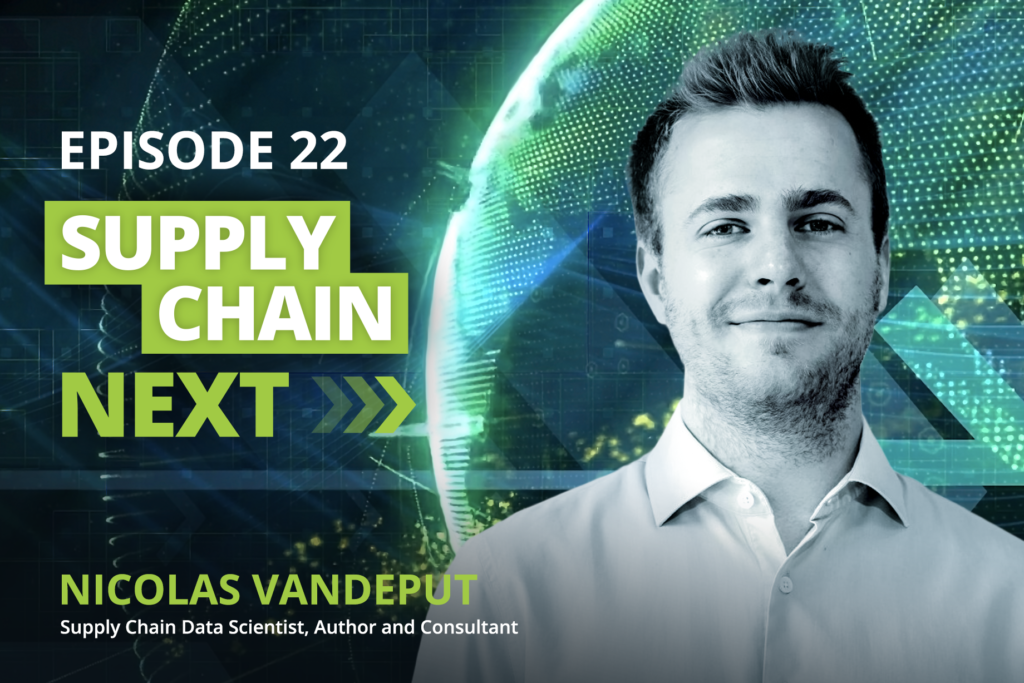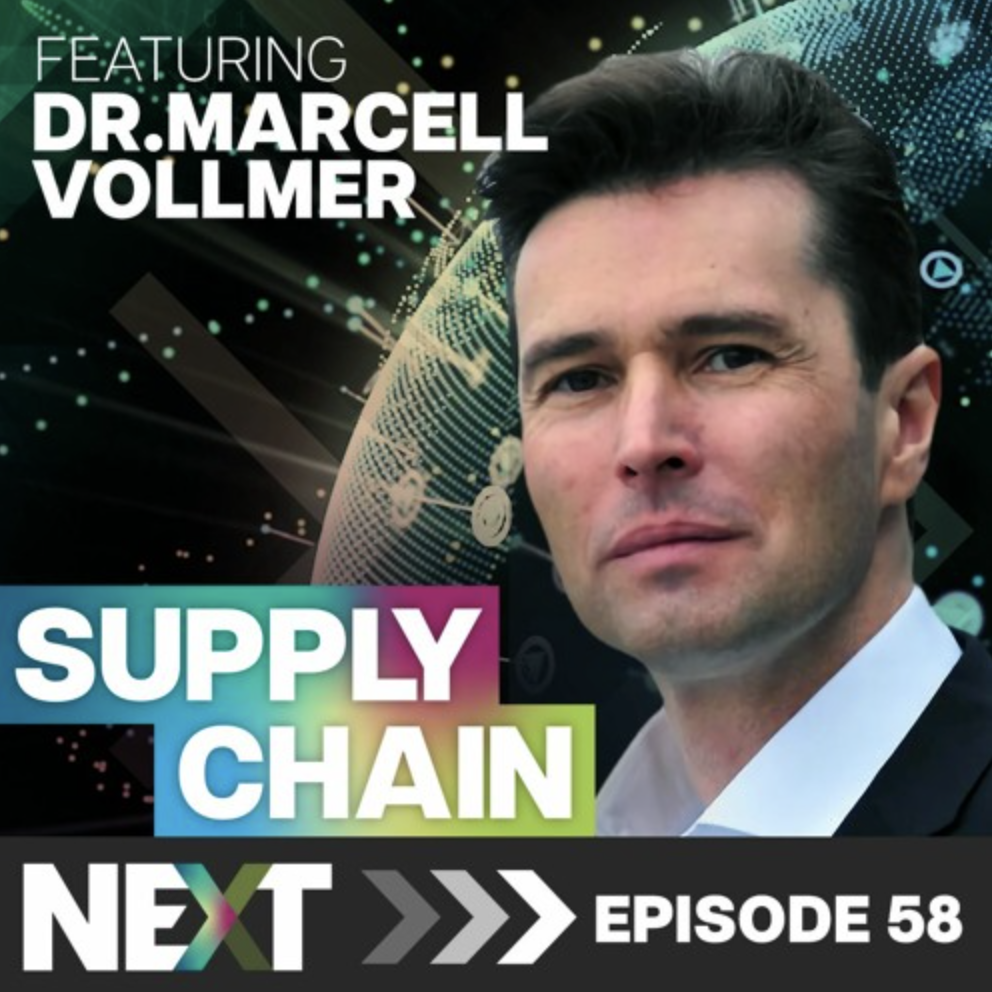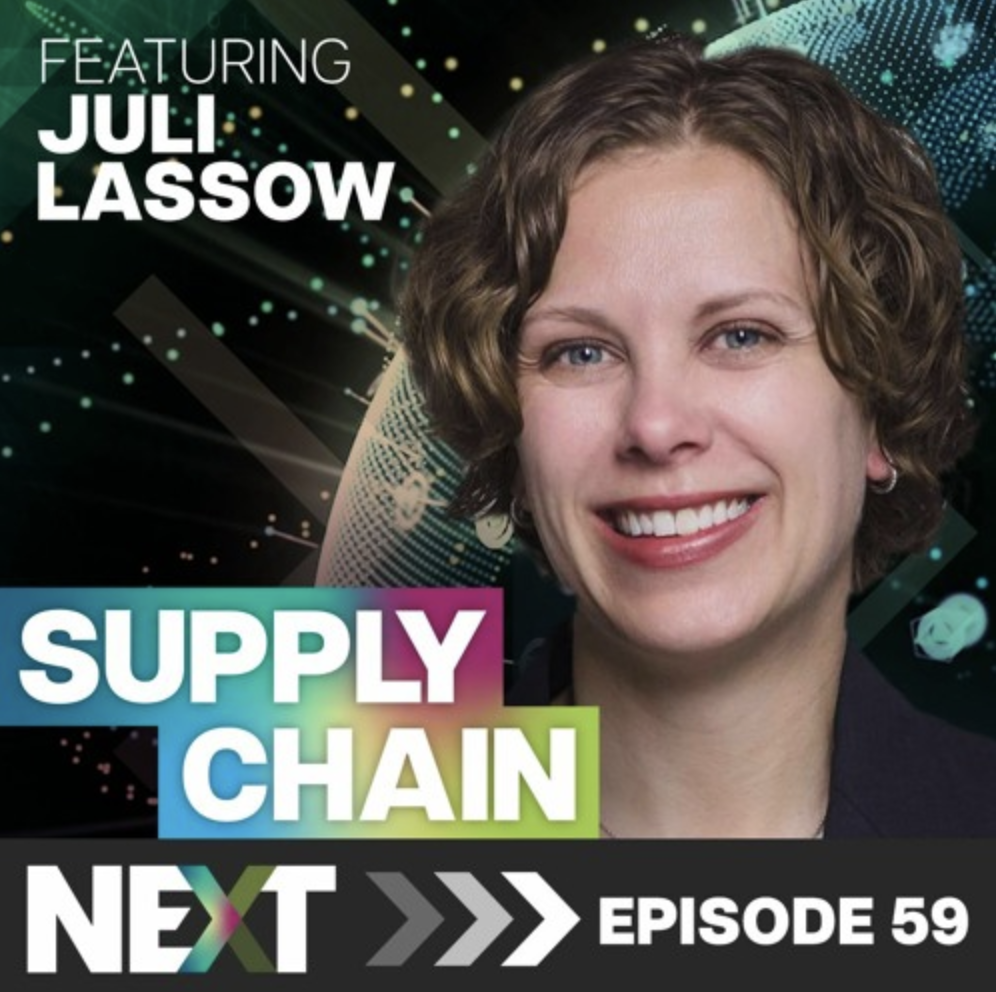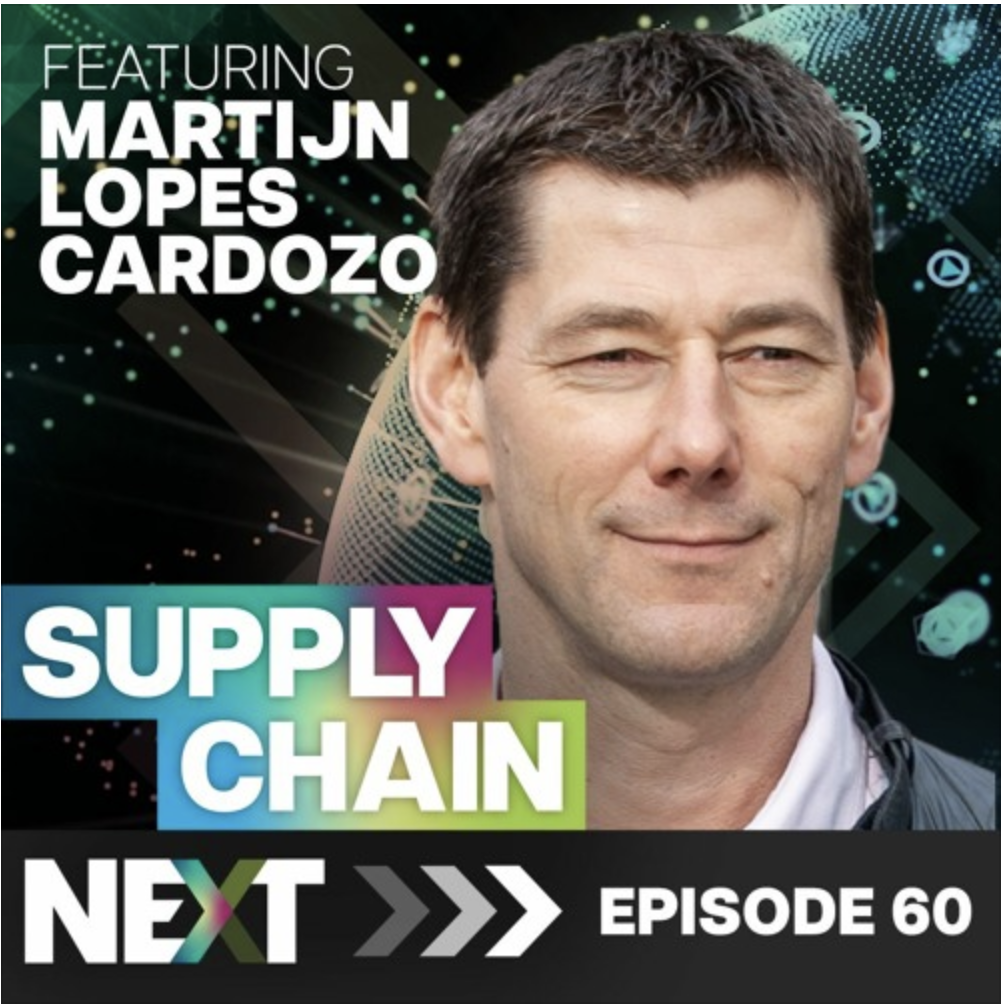Episode 22
Supply Chain Data Scientist Nicolas Vandeput
Nicolas Vandeput is a supply chain data scientist who specializes in demand forecasting and inventory optimization.
He’s also deeply committed to education and sharing ideas. He has taught forecasting and inventory optimization to masters’ level students since 2014. He has also founded SupChains in 2016 and co-founded SKU Science—a smart online platform for supply chain management—in 2018.
Nicolas’ first book Data Science for Supply Chain Forecast was released in November of 2018 and his second book Inventory Optimization: Models and Simulation was released in August of 2020.
On episode 22 of Supply Chain Next Podcast, Nicolas talks with host Richard Donaldson about inventory optimization, the different forms of data processing, and keeping watch on emerging technologies. You can listen to the podcast below, or watch the video version on YouTube.

Transcript from Nicolas Vandeput Podcast Episode
Nicolas, you’ve got a great tale into supply chain via Bridgestone. What happened there that led you into becoming a professor and thought leader in the area of supply chain and demand forecasting?
- I like to describe myself as somebody who is passionate about supply chains, demand forecasting, and inventory management.
- I was in the right time and the right place.
- Back in 2015 nobody was talking about machine learning (ML), it was all new. I was curious to find out if we could use ML in supply chain. I wasn’t the first to ask this question but I was one of the first. I quickly realized that there was nowhere to go online to learn about integrating ML into supply chain.
- There were people using ML in other areas but I was wondering, how do I use it for supply chain? This is how I ended up writing the books. It’s not difficult to use ML. It’s incredible what you can achieve with just a few lines of code.
How did you make the decision to get into supply chain coming out of college?
- Years ago, while I was still at Bridgestone, there was a young intern who asked me what I was doing. I told her that I was responsible for the optimization of the inventory of tires across Europe. She asked me, “When you were young, did you want to do this?”
- In college I began to study supply chain. The great thing about supply chain is that it’s somewhere in between business activities and higher level mathematics such as nuclear physics. So if you want to get very qualitative and quantitative then you just get into supply chain.
- That’s what I love about it. You have people, process, and collaboration. And at the same time you get data and mathematics processing.
So you went into the higher aspects of supply chain such as planning, forecasting, and mathematics. You could have pursued finance, banking, quantitative analytics, derivatives, and the like. What made you get into supply chain instead?
- I enjoy a wide range of subjects, especially the mix between psychology and economics. I just love supply chain but that’s not to say that there aren’t many subjects that I find interesting.
Let’s talk about Bridgestone. That seems to be the moment where you got your hands around global inventory management and forecast planning.
- I always saw my time at Bridgestone as a playground. I was able to look at this huge data set in respect to inventory optimization and demand forecasting.
- It gave me a window into inventory complexity. There were thirty to sixty warehouses across Europe. It was massive. It took twelve to eighteen months before you could really see before you could really grasp the whole supply chain.
- Around this same time you had the rise in ML. It was brand new, people were talking about it but it wasn’t clear how to use it. I took the time to experiment with it and had a revelation. I thought that this was the future.
- The first time I produced results with ML was an exciting moment for me.
ML is a complex topic unto itself, especially in its application to big data sets. How do you explain what ML is? And how do you apply ML to produce usable outcomes?
- I tend to avoid strict definitions. What is most important about ML is that it is a kind of black box. You can use ML with just a few lines of code and it does what it does, similar to how somebody can use a car without knowing how it works.
- You just bring ML to your data set and see if it’s able to output usable data after it’s had time to process the data with its algorithms—but you can’t open the box and see what’s happening. This is a downside to ML for some people.
One of the things that people get confused about is the difference between ML and artificial intelligence (AI). How do you help people navigate the differences between those two?
- I like to tell people to be cautious of these types of marketing buzzwords. There is no real definition for AI. Any kind of computed logic could be called AI. I personally try to never use this term because it has no meaning.
- I prefer ML even though its definition is not perfect yet. The people who use it at least have an idea of what kind of algorithm it is.
- These terms are used for marketing purposes for those who are responsible to buy software for their organization. AI and ML still don’t give any concrete value to buyers. What do they mean by these terms?
I agree. The terms become so oversimplified that they become meaningless. I like to define these terms this way: ML still needs people to ask the questions for it. AI would ask its own questions and doesn’t really exist yet.
- I like your definitions. I find that sometimes people get so optimistic about ML that they expect a magic USB key to contain all of the solutions. This will not happen.
- Other people find ML to be nothing more than a buzzword containing the same old stuff from before but under a new umbrella.
- ML still requires people to bring the data and analyze the data. ML needs people to understand what is going in and coming out.
- It’s not going to be so smart that it can tell you what you need to do to optimize operations in your company.
That’s a big jump from running global inventory at Bridgestone to writing a book on forecasting and planning. How did you make that transition? What inspired you to go in that direction?
- It was a composition of many different things.
- When I was in university I saw the professor addressing the whole class and I thought that this is what I want to do.
- From the beginning I knew I wanted to teach and share ideas.
- In 2014 I gave my first class at university.
- Fast forward a few years and I discovered ML. When you look into it, it’s not that complex and I wanted to share this with people.
- You don’t need higher education to use it. You just code a few lines and you can use it.
- There were no resources available for people to learn from so I started my book in hopes of teaching people about ML and its uses.
- It turned out that people liked my book and the classes I taught. I have received many emails from people saying that they are using my book at their companies and it’s helping them.
- The positive feedback has inspired me to continue to write books and teach people.
You definitely represent a new generation of supply chain professionals who are coming into the industry with a fresh perspective and during a time when supply chain is being reintroduced to the world again.
- Yes. People like forecasting because you can put numbers to it, it’s exciting, it’s new, you can aim to beat the benchmarks.
- I tell people yes, forecasting is exciting, but reducing your inventory is where the money is saved. If you can reduce your inventory by twenty percent you can make money.
- Inventory optimization is not a sexy thing. Nobody is interested, it’s full of math, it’s difficult to understand, so people prefer to stick to forecasting.
- I still find it difficult to get people interested in inventory management. And I try because this is where the money is.
What do you think is the simple goal of an enterprise and its inventory management?
- The answer to this can involve increasing profit, more accurate forecasting, and higher service levels, so it helps to ask what do we want to accomplish?
- I’d like to ask supply chain people if you have two or three months of inventory do they know what kind of stock it is? Is it safety stock? Was it leftover? Was it forecasted for future sales? They are often unsure of the answer.
If you ask me, the goal is to have the least amount of inventory with the maximum amount of business output. So if I were a business I could have no inventory at all and have no costs, or I could buy all the inventory in the world and sit on it while it costs me money. You want to have just enough, the “Goldilocks amount”, not too little or too much. Just right in the middle.
- It’s a tricky balance to achieve. In my inventory book I wanted to answer the simple question: how much inventory do we need? What is the optimal service level?
- You only need to divide a few numbers to get the optimal service level. I am amazed that nobody is using it.
The academy came up with a fraction that divides two numbers which can give you your optimal service level.
You’ve got the demand from consumers, the business operations, and profitability. Finance, operations, and supply chain. Nobody has ever really connected those dots to cohesively create a model from which to improve all aspects of the business.
- That’s why real inventory optimization is so difficult. You need to know your supply chain so well, what I would call the heartbeat of your supply chain. It beats every day, week, month, and how fast do you react to it? You need to understand the demand and forecasting. You need to know your clients.
- Then you need to go to the finance guy to get a view of profitability. Just imagine, you need all of this information just to get a view for inventory optimization.
- This is where the savings really come from. If you can reduce your inventory by twenty percent you can save so much money.
So you’re saying that profitability needs to be accounted for in any supply chain planning?
- Yes. But when doing forecasting people give equal weight to all of the items in the supply chain. For example, hammers are worth more than nails. If a few nails go missing it doesn’t matter but when hammers go missing it starts to dig into your profits. So you should really focus on the hammers, not the nails.
- When you compute your forecast try to weigh the items accordingly. I find that people aren’t putting the emphasis on what really matters.
- We need to ask supply chain people to pay attention to what is worth money and what isn’t.
In terms of natural resources and sustainability, there’s an impact if we start thinking about circularity in the global supply chain. How do you incorporate this into how you do forecasting?
- It is a very important thing, yes. In my own consultancy company I am offsetting all of my carbon dioxide emissions so I’ve already reached the goals for the Paris Agreement for 2050.
- Any action that you take to make a supply chain more efficient will help to reduce resource consumption.
- The more accurate your forecasting the less likely you will end up with obsolete inventory that will have to be destroyed.
- If I manage to reduce somebody’s inventory by twenty percent that’s less stuff that will have to be disposed of.
How do you see the use of recycled materials, like metals, from the inventory forecasting perspective?
- For me the use of recycled materials would be just the same as any other supplier. For example, I would consider the lead times, the quality of the metals, and does it meet my requirements?
- Once you look at an optimization model you can optimize for profit and carbon dioxide emission reduction simultaneously.
- There are also examples where it makes sense to reduce inventory to avoid recycling the inventory at a later date.
All of this requires that you have data. I imagine that sometimes when you go in to look at the whole picture the data isn’t there. What are the challenges you see when it comes to getting your hands on the data regardless of the model you’re working with?
- As a teacher and an author I show what is possible with the various models. As a consultant I ask my clients, what kind of data do you have? Do you have the pricing of every SKU for the last five years that you’ve sold? Do you know what your sales will look like for the next six to eight months? Most of them do not have this data or say that it will take six months to get it.
- Without the data it’s not possible to start working on forecasting. I will generally start with a simple model and go from there if the data is difficult to get.
Are there common problems that you see in the lack of data that companies have?
- It is very difficult to solve all of the data issues in just one shot.
- Most of the people in supply chain simply do not have the data architecture in place to begin collecting.
- The driving tech in supply chain now is Microsoft Excel.
- Excel is great for small stuff but lacks the usability required for end-to-end supply chain solutions. If you start to use Excel for data collection you quickly see that it is extremely messy and slow. And then every person in the company begins to have their own spreadsheet for a database and it becomes a total mess.
- If you ask three different teams for the same dataset, they’ll come back with three different numbers from three different excel files/data sources.
- I promote data architecture in supply chain.
- By teaching people in supply chain Python instead of Excel they learn how to manipulate much larger sets of data more accurately.
Agreed. I find that people in supply chain must not only become business experts but technology experts too. Being a data-driven culture we have to ask ourselves: am I capturing the right data? Do I have the right data fields? The right architecture for future modeling? If everyone was using at least the same spreadsheet we could begin to force data harmonization. We need to start using common tools but consistency is required.
- I agree. One of my managers from the past told me that there was no need for extra data and that supply chain only keeps maybe thirty six months of data going backward.
- I am always pushing my clients to collect and store more data.
- We conducted an experiment to prove that more data means better forecasting. I purposely withheld some data from one of my students to prove that the less data you have the lower quality of the forecast.
- I understand that it’s difficult for a manager to agree to collect data when they don’t know what it will be useful for.
- Data is the foundation for any quantitative endeavor you want to undertake in supply chain. It makes sense to do quantitative analysis considering the age we live in—and if you’re not going to do it, your competitor is going to do it for you.
Let’s look forward here. You just had a book come out in August 2020. What does the publishing calendar look like for you?
- In April we will release the second edition of my data forecasting book. I’ve been working on it quite a lot. I started every chapter from scratch to ensure that I am explaining things more comprehensively than the first time around.
- I am aiming for improved simplification of the material. The easier things are to understand the better.
- I added a chapter on neural networks. Interestingly enough the first neural network was constructed in the 1950s. It’s great to think that even back then there were people thinking of such things.
Let’s unpack the term “neural network”. What do you mean by neural network?
- This one is easy because a neural network is a neural network. There is no confusion on what it is. It is simply a subtype of ML.
- I’m not saying it’s the best, it’s just another tool that we can use. There could be situations where it might not help.
- In the book I wanted to show that a neural network could be used with just a few lines of code. It’s very easy to use even if you don’t understand every single math concept involved.
- The whole book is about telling the reader that they can do it themselves.
So a neural network is an advanced type of ML? It has more connectivity and it can do more processing?
- Yes, and it is evolving extremely fast.
- In 2020 we had an international forecasting competition and many people, including myself, thought that neural networks would outshine all of the other statistical models. It didn’t happen. Neural networks were beat out by another type of ML known as “gradient boosting”.
- Five years from now there will probably be something else that is considered the best.
Once automation begins it gains momentum very quickly, like in the case of driverless cars. Forecasting is the ultimate supply chain dream and we are in a time of definite change. In this new era supply chain will be driven by technology and innovation. What do you see coming in the big trends of supply chain in the next five to seven years?
- That is a difficult question for me. I spend my time thinking about forecasting. I am not so much into making predictions as it is hard to know what trends will emerge.
- What I do is stay current in my field so I can learn of new developments as soon as possible.
- I want to stay open to any new technique or technology.
- There are people who become so enthusiastic about one type of technology that they have a difficult time transitioning to newer technologies when they arise.
- I want to give my readers the methodology and approach to keep an open mind, a scientific mind that is ready for new changes.
In a way it could be said that you did make a prediction: that supply chain professionals have to adapt to the new normal and that it is beneficial to keep an open mind and give new technologies a chance. Change is happening all of the time.
- The advice I have does not relate to how the world is going to be in five or ten years, since accuracy is difficult to achieve in such predictions. Instead we should ask ourselves, how do I stay on the move? How do I learn new things? How do I stay open to learning new ideas?
- In 2016 and 2017 I spent seven hundred hours to become an expert with Python and it changed my life. Back then would I have been able to predict that after learning Python I would have come all this way?
- I’m just trying to stay open to the possibilities the future will bring.
You remind me of an old phrase that’s an amalgamation of what we’ve been talking about: the student wants to become a master and the master wants to remain a student. We must continue to learn as much as we can.
- Yes. After writing this whole book on inventory and at the end I say to myself that I know that I know nothing. And this is especially true in supply chain. There are so many people and processes active everywhere that you need to learn about it.
- If you meet somebody who says that they know everything about inventory optimization and data science there’s a good chance that they don’t.
More about Nicolas Vandeput
Nicolas can be found at medium.com and he is also ready to connect on LinkedIn. The second edition of his book Data Science for Supply Chain Forecasting releases April 2021.
More Episodes
You can listen to our audio tracks and read highlights for each episode below.
We’ve also started publishing video episodes on our YouTube channel.
058 – Dr Marcell Vollmer – Tech in Supply Chain, and the Sustainability Shift
Supply Chain Next · 058 – Dr Marcell Vollmer – Tech in Supply Chain, and the Sustainability Shift Meet Dr. Marcell Vollmer Dr. Marcell Vollmer, a renowned expert in the fields of digitalization, innovation, and sustainability. Marcell is a sought-after speaker and author that has dedicated his career to helping companies and individuals navigate the rapidly…
059 – Juli Lassow – Revolutionizing Retail, Sustainable Strategies, & the Future of Partnerships
Supply Chain Next · 059 – Juli Lassow – Revolutionizing Retail, Sustainable Strategies, & the Future of Partnerships Juli Lassow ,founder of JHL Solutions Meet Juli Lassow Juli Lassow, an accomplished retail professional, speaker, writer, and sustainability advocate, is the founder of JHL Solutions, a consultancy focused on creating outstanding private-label partnerships. With a deep…
060 – Martijn Lopes Cardozo – Circular Supply Chain
Supply Chain Next · 060 – Martijn Lopes Cardozo – Circular Supply Chain Martijn Lopes Cardozo, CEO at Circle Economy Meet Martijn Lopes Cardozo Martijn, a seasoned entrepreneur, has an impressive track record of establishing prosperous ventures within the realms of software, mobile, and digital media in California. Upon returning to the Netherlands, he…



